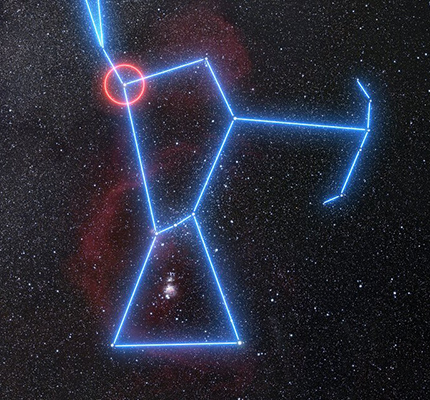Betelgeuse has the most name recognition of the known supergiant stars, due partly to its proximity to the Sun (a mere 724 light-years away) and partly to its prominence in a well-known constellation (it’s Orion’s right shoulder). But if you’re looking for a star about to go supernova, Miguel Montargès has a few more promising candidates he can recommend. “I always say VY Canis Majoris,” he suggested. “It’s only 5 times farther away than Betelgeuse, but it’s also brighter because it’s much older,” though it’s hard to see through its thick blanket of obscuring dust.
Betelgeuse is young among supergiant stars, which include some of the largest and most evolved stars that still undergo nuclear fusion. By “young,” astronomers mean that Betelgeuse is still tens of thousands of years away from a catastrophic meltdown. That doesn’t stop the world from watching with bated breath whenever it behaves peculiarly.

The intrigue stems from the fact that astronomers are still learning how some of the physical processes that lead to a supernova manifest visibly, said Montargès, an astrophysicist at Observatoire de Paris in France. Betelgeuse, however, is not likely to take us by surprise. Montargès is part of a subfield of astronomers who regularly observe supergiant stars to better understand the very last stages of a star’s life cycle. “There are thousands of red supergiants in the galaxy, and I would say 100 or 200 that are nicely visible from Earth,” he said. “And of those, there are about 10-ish that we are observing regularly. Betelgeuse is the most observed by far.”
Montargès has been observing Betelgeuse for years to understand the processes rapidly propelling it toward its explosive end. In January 2019, he led an observing campaign on the Very Large Telescope (VLT) in Chile to study the star at the faintest point of its regular 400-day cycle of brightness variation. Months later, when he was just beginning to analyze those data, the first reports started coming in that Betelgeuse was dimming rapidly and unexpectedly. The period, now called the Great Dimming, prompted astronomers around the world to swing their telescopes toward Betelgeuse to catch whatever happened next.
Colder or Dustier? Actually, It Was Both
Proposals to observe with major telescopes like VLT can take weeks or months to be approved during normal review cycles. But thanks to the small allotment of telescope time known as director’s discretionary time (set aside for sudden and unexpected astronomical events), Montargès and his team could jump to the front of the queue. They applied to study the Great Dimming with VLT and the VLT Interferometer late in December 2019, and days later their request was approved. “I was asked to send in the observing commands immediately, and [the star] was observed the same night,” he said.
He initially set out to prove that nothing at all atypical was going on with Betelgeuse. “And I was wrong,” he quipped. As the dimming continued, the team applied for more discretionary observing time so they could see the entire event from beginning to end. They were awarded two more chances to observe Betelgeuse with VLT instruments: one right when the star was at its faintest and one as it started to brighten again. It was just in the nick of time: Paranal Observatory, which hosts VLT, closed because of COVID-19 safety concerns just 3 days after the researchers collected their final set of observations.

These new observations, combined with archival data from professional and amateur astronomers around the world, revealed that Betelgeuse’s Great Dimming was caused by a large mass loss event on the star’s surface. The mass loss event cooled the star’s southwestern quadrant by an estimated 500°C, which then triggered the expelled gas to condense into dust, “like dew forming on the outside of a glass of ice water, except dark,” science communicator and astronomer Phil Plait explained on Twitter. The combination of the quick cooling and the dust obscuration made Betelgeuse’s southern hemisphere appear about 10 times fainter than it should have been (see video below).
Large mass loss events like this one, during which Betelgeuse created a cloud about a tenth of the mass of Earth, are theorized to be a regular occurrence during the supergiant phase of a star’s life. VY Canis Majoris, for example, may have already expelled half its original mass and is obscured by a thick veil of dust. However, Betelgeuse’s Great Dimming is the first time a large-scale mass loss event has been monitored in real time for this type of star. The researchers published these results in Nature on 16 June.
Are Great Dimmings Normal?
Even though astronomers have pinned down the likely cause of Betelgeuse’s Great Dimming, they can’t answer whether supergiants lose most of their mass by a continuous stellar wind or through large mass loss events like this. “Did we see this event on Betelgeuse because there is something special about this star, or [did] we see it because that’s the one that we’re observing the most?” Montargès asked. Astronomers have never seen this type of event on another supergiant star, “but perhaps it is because we are not looking.”
Pandemic-related observatory closures in 2020 and 2021 stymied some of the researchers’ hoped-for follow-up observations, but they are continuing to apply for telescope time with VLT and other telescopes. A forthcoming proposal to observe Betelgeuse with the Atacama Large Millimeter/submillimeter Array (ALMA) aims to pin down the chemical composition of the dust that condensed from the expelled stellar material.
Farther down the line, Montargès explained, the continuous monitoring capabilities of the Vera C. Rubin Observatory, scheduled to come online in 2023, and the more sensitive eye of the Extremely Large Telescope, scheduled to come online in 2025, will help fill the gaps in our understanding of not just Betelgeuse but also other supergiant stars that remain under-studied.
—Kimberly M. S. Cartier (@AstroKimCartier), Staff Writer






